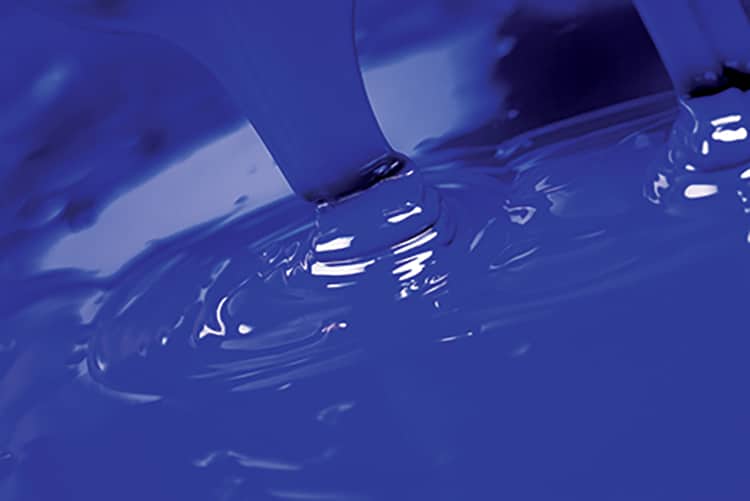By Clifford K. Schoff, Schoff Associates
This is a continuation of the article begun in the September 2020 issue of CoatingsTech. Part 1 ended with film formation but had not discussed paint flow, which occurs during making of the paint, its application, and through film formation. The formulation undergoes a wide range of shear stresses on pigment dispersion, mixing, storage, application, and post-application. It responds to these stresses with variable flowability (viscosity), which depends on solids (resin and pigment), resin molecular weight, pigment dispersion quality, flow additives, wetting agents, etc.
The viscosity level during the different operations affects those operations. For example, too low a viscosity during pigment dispersion means poor shearing action and inadequate dispersion; too high a viscosity may cause shear thickening of the paste and jamming of the mill. Too low a viscosity during application (a high shear process) can cause spattering, drips, and sags; too high a viscosity makes brushing exceedingly difficult and prevents flow and leveling. In a spray application, it makes atomization impossible so that there is no spray pattern as such. Viscosity measurements at high shear stress/rate are useful in predicting application properties, and measurements at low shear can help evaluate flow and leveling and tendencies to sag. This should be done with viscometers that can measure viscosity over a range of shear stresses or shear rates. One-point measurements (Ford cup, Zahn cup) offer snapshots at one shear stress/rate, but do not indicate overall flow behavior.
Viscosity measurements at high shear stress/rate are useful in predicting application properties, and measurements at low shear can help evaluate flow and leveling and tendencies to sag.
Let us go back and look at the step right after film formation, which is drying. In the drying period, solvent evaporation changes from surface control (wet surface, rapid loss) to diffusion control (dry surface, slow loss). The film is dry to the touch, but not completely dry due to retention of solvent. The coating is likely to be soft enough that it is easily damaged, collects dirt, and probably has poor block resistance. It may continue to flow (particularly true for high solids coatings) and show poor chemical and water resistance. Retained solvent and additives can cause blistering and reduce corrosion resistance. Solvent retention can be prevented or reduced by using faster, more linear solvents that leave the coating more easily and/or softer more linear polymers that are less apt to trap solvent. Solvents can be forced from air dry coatings with IR lamps or hot air blasts. Baked coatings lose most solvents but may hold on to very low evaporation rate solvents. Yet another way to enable solvents to escape is to keep the coating surface open by delaying or slowing cure. This can be done by using a less active catalyst, less crosslinker, or a crosslinker with lower functionality.
Now that I have mentioned cure, what is it and how does it relate to formulation? One definition of cure is “the removal of solvents and achieving of sufficient molecular weight to give properties that meet the user’s needs.” The customer decides whether the coating will be air-dried or baked along with a cure specification, such as a certain number of MEK rubs or a combination of physical properties. Depending on the customer and the end use, the formulator may have considerable latitude in designing chemistry to produce a coating that meets that specification. Cure may or may not involve crosslinking. It may just involve the loss of solvents (including water). Lacquers and most latexes have high enough MW to not need crosslinking. However, crosslinking provides many advantages. After application, it causes increases in molecular weight and viscosity that give sag resistance yet allow flow and leveling. Ultimately, a solid film is formed that has good film integrity, hardness, toughness, and solvent resistance. Crosslinking allows the use of low MW polymers and oligomers that make high solids coatings practical due to low application viscosities yet moderate to high viscosities during and after the curing process. Thermosetting resins such as acrylic- and polyester-melamines and the more reactive epoxy-amines, polyol-isocyanates, and alkyds (oxidative cure) build molecular weight through crosslinking. Except for oxidative cure, the curing process takes energy, which usually is heat, but can be UV, electron beam, or microwave radiation. The degree of cure depends on the amount of energy, although catalysts can increase the rate of reaction.
Cure can be monitored and evaluated in the laboratory by a variety of techniques, including dynamic mechanical analysis (DMA), thermal mechanical analysis (TMA or indentometer), differential scanning calorimetry (DSC), oscillatory rheological measurements, tensile and elongation measurements, Fourier transform infrared spectroscopy (FTIR), dielectric spectroscopy, and measurement of extractables/gel content. Less esoteric methods are more common. Examples are solvent rubs (ASTM D 5402), pencil hardness (ASTM D 3363), indentation hardness (ASTM D 1474), and rocker or pendulum hardness (Sward – ASTM D 2134; König and Persoz – ISO 1522). Unfortunately, such techniques are subjective, have poor precision, and are difficult to relate to material properties or performance. However, if used carefully, they can give rapid estimations of whether the coating has adequate properties for its end use.
When finished, the formulator should have a fine coating that passes all the tests and has excellent properties. Now, it must be scaled up in a pilot plant or go directly to the paint plant. In both cases, shear stresses/rates, addition and letdown rates, and temperatures are different from the lab. The increase in batch volume changes shear and flow patterns and affects mixing. This is where developing relationships with the engineers in the pilot plant and/or paint plant can be beneficial and enable manufacturing problems to be headed off before they happen. A formulator can learn valuable lessons about what works in the plant and what does not without finding this out the hard way.
CoatingsTech | Vol. 17, No. 11 | November-December 2020
